![]()
![]()
![]()
Use LEFT and RIGHT arrow keys to navigate between flashcards;
Use UP and DOWN arrow keys to flip the card;
H to show hint;
A reads text to speech;
95 Cards in this Set
- Front
- Back
|
What is a temporary organ connecting fetus and mother providing the equivalent of respiratory (and renal) services? |
Placenta |
|
|
What is a membranous sac surrounding the fetus containing serous fluid essential for |
Amnion |
|
|
What is a plate-shaped tissue under part of amniotic sac containing fetal blood vessels that branch into villi projecting into space filled with maternal blood? |
Chorion |
|
|
What is an outer layer of blastocyst (from fertilized ovum) that implants in uterus and forms placenta? |
Trophoblast |
|
|
What is the outer layer of placenta that normally peels off myometrium? |
Decidua |
|
|
What is syncytium of cells forming outer covering of chorionic villi, which thin out their cytoplasm and let their clumped nuclei hang off villi in “syncytial knots” to minimize diffusion barrier? |
Syncytiotrophoblast |
|
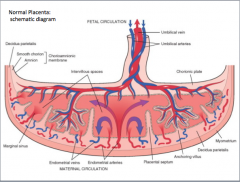
Draw this out. |
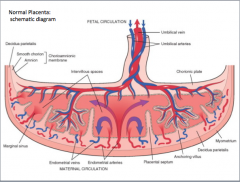
|
|
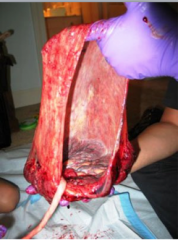
What is this? |
Amniotic sac |
|

What is this? What is the fetal side of the placenta? What is the maternal side? |
Top = normal fetal (amniotic) side of placenta
Bottom = maternal side of placenta |
|

What is the trimester of each?
What are the chorionic villi covered by during the first trimester?
What are some blood vessel, interstitium, trophoblast changes to the villi during the third trimester? |
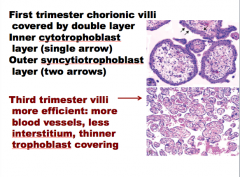
|
|
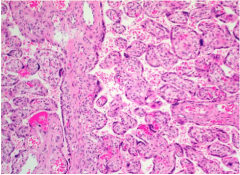
What is shown? Around what weeks? |
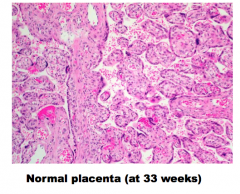
|
|
|
What is implantation of a pregnancy anywhere besides normal intrauterine location?
How often does this occur? Where do 90% occur?
What is the most common pathogenesis (up to 50%)? What is another cause? |
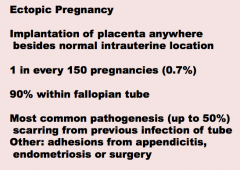
|
|
|
What is the most common presentation of ectopic pregnancy? (pain where, why?, blood, how long, can lead to what two serious things?)
How do you diagnose? (four things)
What is the treatment? Is the prognosis good or bad? |
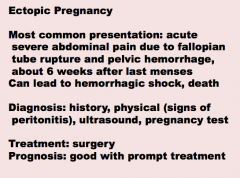
|
|
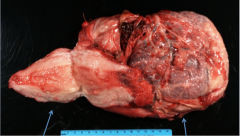
What is shown here? What are the two arrows pointing at? |
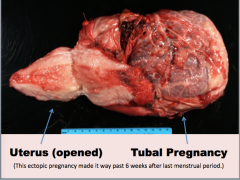
|
|
|
What is the definition of spontaneous abortion?
Occurs in what percent of clinically unrecognized pregnancies? Sensitive gonadotropin assays show that what percent of more pregnancies abort spontaneously? Most in what trimester?
How much does the rate increase between 20 year olds and 4o year olds? |
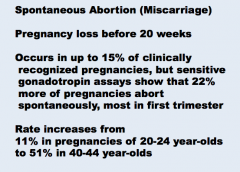
|
|
|
What is the most common cause of pregnancy loss in each?
First trimester? 1/2 with what abnormalities?
Second trimester? What disease?
Third trimester? |
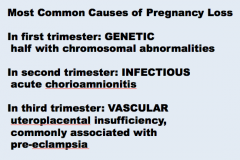
|
|
|
What are the common causes of recurrent spontaneous abortion? What are recurrent stillbirths associated with (what states)? |

|
|
|
What is implantation in the LOWER UTERUS or CERVIS, sometimes covering internal cervical os?
What does it often result in?
How do you diagnose it? What is the treatment? |
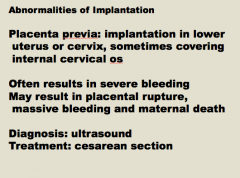
|
|
|
What is defective decidua, with adherence of villous tissue to myometrium? |
Placenta accreta |
|
|
What is defective decidua, with penetration of villous tissue into myometrium? |
Placenta increta |
|
|
What is defective decidua, with penetration of villous tissue through entire uterine wall? |
Placenta percreta |
|
|
What are the relative percents of placenta accreta, increta, and percreta?
They can cause persistent what?
What are the two three treatment options? |
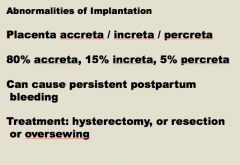
|
|
|
What are abnormal gestations due to two sperm fertilizing one egg or one or two sperm fertilizing an "empty egg" with absent or nonfunctional DNA?
Are they rare in the US? In what part of the world are they the least rare? Tend to occur in what ages of women?
|

|
|
|
Complete moles are_______ Partial moles are ______. |
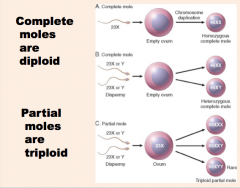
|
|
|
What makes hydatidiform moles resemble grapes?
What hyperplasia is more prominent in complete moles (usually all the way around villi)? |
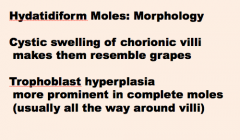
|
|
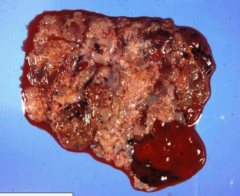
What is this? |
Hydatiform mole |
|
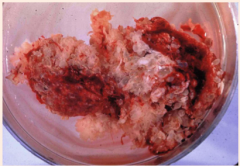
What is this? |
Hydatiform mole |
|

What is this? |
PARTIAL hydatidiform mole |
|
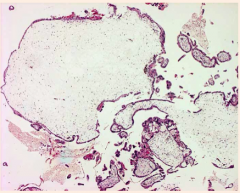
What is this? |
Partial hydatidiform mole |
|
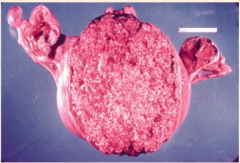
What is this? |
Complete hydatidiform mole filling and distending uterus |
|
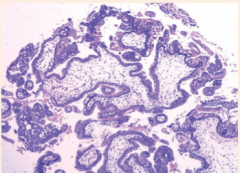
What is this? Any hyperplasia? |
Complete hydatidiform mole: Circumferential trophoblast hyperplasia |
|
|
When are hydatidiform moles often diagnosed? Why? Ultrasound showle abnormally rapid and high elevation of what?
How do you treat it? What do you monitor to make sure it is all the way out? |
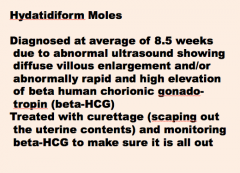
|
|
|
What are the four types of twin placentas? Draw each. |
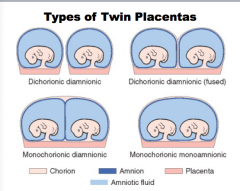
|
|

69% of twin placentas are what type? 80% of this type of placenta are "__zygotic." |
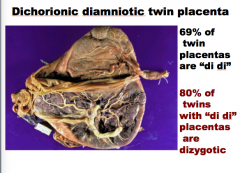
|
|
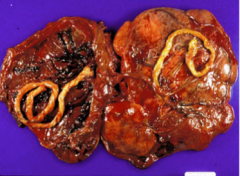
What type of placenta?
30% of twin placentas are what type?
All twins with this type of placenta are what? |
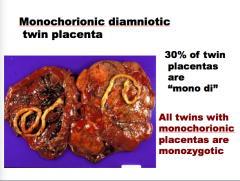
|
|
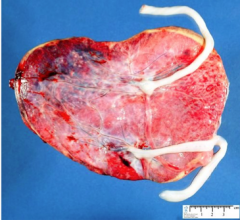
What is twin-twin transfusion syndrome? What type of placenta? |

|
|
|
Twin-twin transfusion:
Death of the deprived “donor” twin can send necrotic ______ material into the ______ threatening the life of the other twin and then the ______. |

|
|
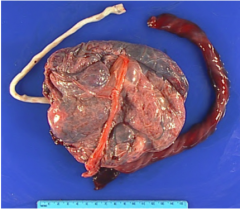
What is this? |
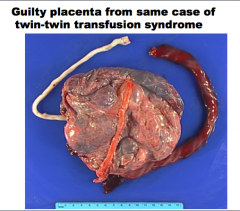
|
|
|
What is the acronym for hematogenous infections?
What does each stand for?
What infection ascends from the vagina?
|
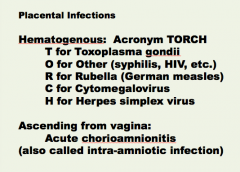
|
|
|
Transplacental infections:
Hematogenous: What does T stand for? Where does it come from? What can it cause?
What does the O stand for? Are they all rare in the US with prenatal care? |
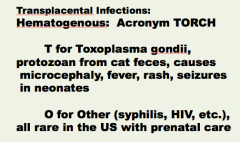
|
|
|
What does R stand for? What can it cause?
|

|
|
|
What does the C stand for? What does it cause? |

|
|
|
What does the H stand for? What are some things that it can cause? In neonates it is preventable with what? |

|
|
|
Acute chorioamnionitis:
Is it common or uncommon? Rupture of membranes at what weeks? (percentages)
What are the stages? (draw the pathway)
Inflammation is procoagulant (true or false) |
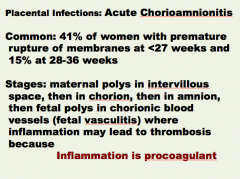
|
|
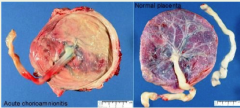
How will the placenta appear when it is infected? |

|
|
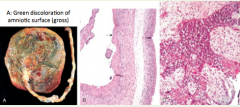
What is the condition? What is shown in B? What is shown in C? |
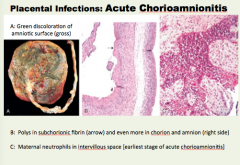
|
|
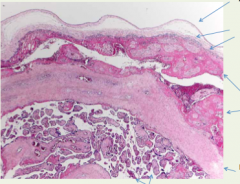
What is the condition? Labels each arrow (placental septum, chorionic villi, subchorionic fibrin with entrapped villi, wavefront of ploys starting to infiltrate, amnion). |
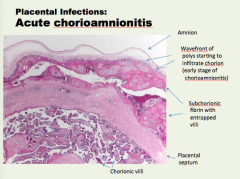
|
|
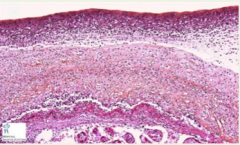
What is the condition? What stage? What features tell you that it is this stage? What are 95% of the blue dots? |
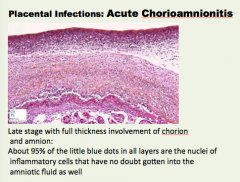
|
|
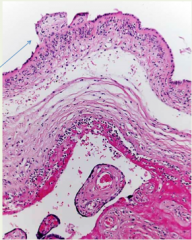
What is the condition? What has happened where the arrow is pointing? In what two locations do you see many inflammatory cells? |
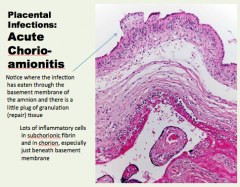
|
|
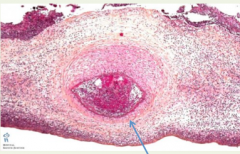
What is the condition? What two things is it complicated by? If this thrombosis occludes the umbilical cord blood, what is the result? Remember, inflammation is ______________________. |
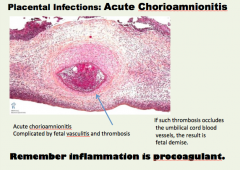
|
|
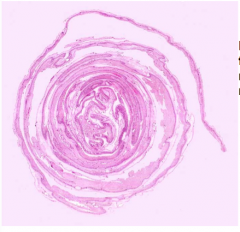
What is shown here? |
Normal fetal membrane roll |
|
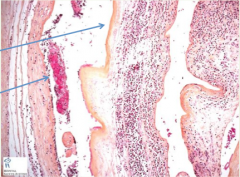
What is the condition? What do you notice occurring at the top arrow? Bottom arrow?
Remember, inflammation is ____________. |
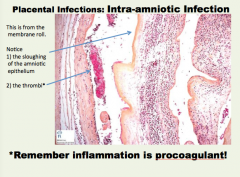
|
|
|
Acute chorioamionitis:
Infection ascends from __________ and _________.
Inflammatory response: mainly maternal _________ (so starts in the ____________ space).
Causes premature rupture of ____________ (acronym PRO__) and premature labor and delivery due to ______________ . |

|
|
|
Placental Infections: Acute Chorioamnionitis
Infection is usually __________, with
Syndrome: fever, _______ (fetal and
Diagnosis: clinical
|

|
|
|
PRE-ECLAMPSIA: Pathogenesis
Normally, trophoblast cells invade _______ spiral arteries going to the placenta, destroy the _________ cells in their walls and convert them from small caliber ______ vessels to large caliber capacitance vessels that accommodate vastly _______ blood flow later in gestation.
|
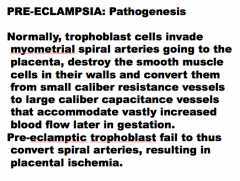
|
|

|

|
|
|
Pathogenesis of Pre-eclampsia
Ischemic placenta releases ______substances:
This blocks _____ and ______ mediated production of nitric oxide and _______, causing maternal hypertension, proteinuria and _______. |
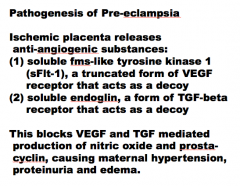
|
|
|
Pathogenesis of Pre-eclampsia
|

|
|
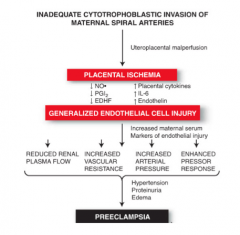
|
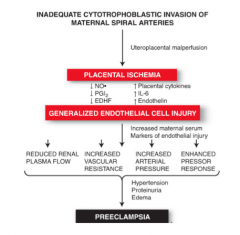
|
|
|
Pre-eclampsia has numerous _______ effects in the placenta and on the fetus and the mother, including fetal intrauterine growth restriction (IUGR), maternal ________, maternal HELLP syndrome. What are the components of HELLP?
Pre-eclampsia and eclampsia are associated with visible changes in placental _______ very similar to atherosclerosis (a universal disease of arterial endothelial injury in all permanent organs).
|
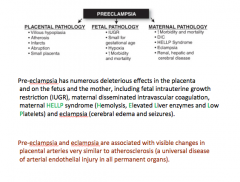
|
|
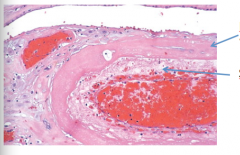
What is shown? What are the two arrows pointing to?
What looks like necrosis can be just _____ of plasma. |
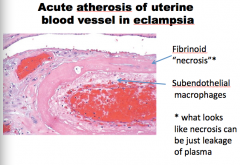
|
|
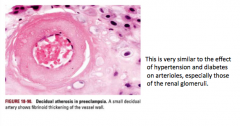
What is shown? |
Pre-eclampsia |
|
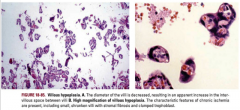
The initial effect of ischemia on the development of chorionic villi is accelerated |
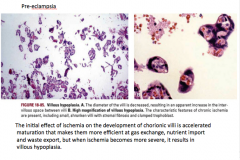
|
|
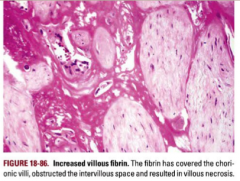
Sluggish blood flow in the _________ space and the ________ state of pre-eclampsia can lead to ______ clot formation in the intervillous space, which can lead to _____ of villi, “choked off” by the ______ around them. |

|
|
|
What are the there components of HELLP syndrome? It is a complication of pre-eclampsia in what percent of patients with pre-eclampsia?
What is the pathogenesis of HELLP syndrome? (draw the pathway). |
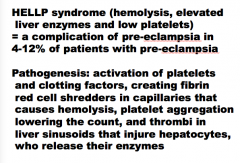
|
|
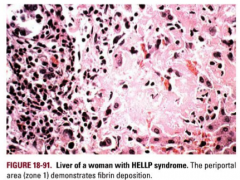
In HELLP syndrome, liver injury can progress to _______, hemorrhage, even liver ________.
20% of patients with HELLP syndrome get _________; some get hepato-renal failure, some pulmonary edema and acute respiratory distress syndrome (ARDS), and ______ die of it. |
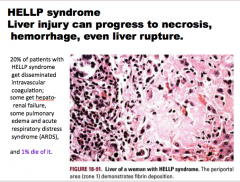
|
|
|
Placental Ischemia and Infarction:
______ is the overwhelmingly most common cause, but hyper-coagulable states, autoimmune vasculitis and ______ are also causes of it.
The fetus can tolerate infarction of more than ______ of the placenta, but extensive infarction causes ___________, neurologic injury and fetal demise. |
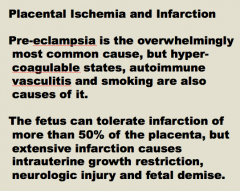
|
|
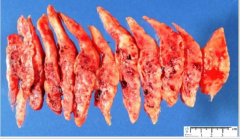
What is shown here? How do you know? |
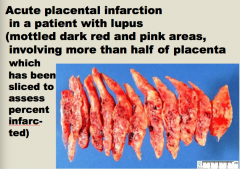
|
|

What is shown here? What are the arrows pointing to? What is the tan area? Light red area? |
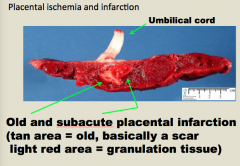
|
|
|
Invasive Mole and Choriocarcinoma:
Basically, there is a spectrum from non-invasive moles through invasive moles to _______.
|
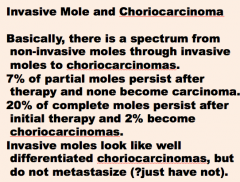
|
|

What is shown in each? Is there invasion? |
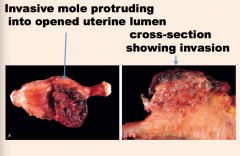
|
|
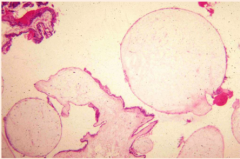
What type of mole is this?
Edematous _____-like chorionic villi |
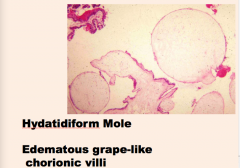
|
|
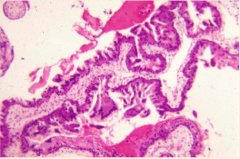
What type of mole? What type of hyperplasia? |
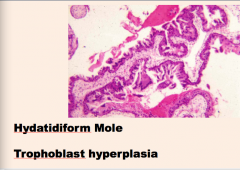
|
|
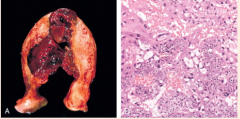
What is shown? Are they rare? |
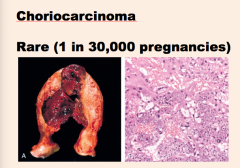
|
|
|
What are some common sites of metastatic choriocarcinoma? |
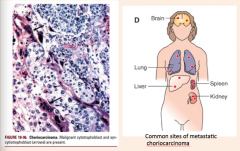
|
|
|
How does choriocarcinoma spread? So where does it go first? What is the most common first symptom? What is the treatment? What is the prognosis if mets? |
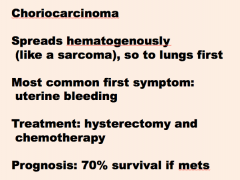
|
|
|
Oligohydramnios
Deficiency of _________
Causes a sequence of compressive injuries to the _______, but also pulmonary _______ because the fetus needs to “breathe” for normal ________ development, and absence of fetal “_______” in amniotic fluid due to fetal _______ disease causes pulmonary ________ incompatible with life after birth. |
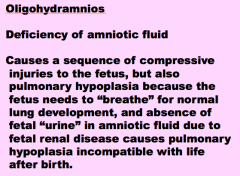
|
|
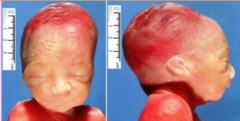
What is the condition?What is contracted?What would a more severe deformation show?
What is the facies? |
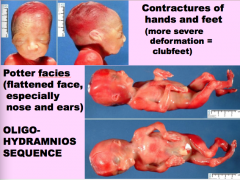
|
|
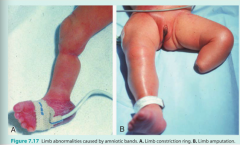
What are amniotic bands? |
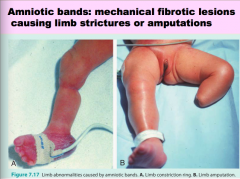
|
|
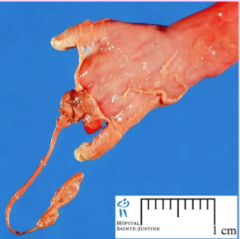
What is this called? |

|
|
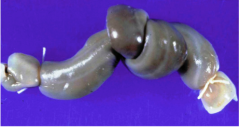
Umbilical cord true knots occur in ______% of pregnancies and can cause ______ demise, especially in the ______ trimester when fetal movement can pull on it. |
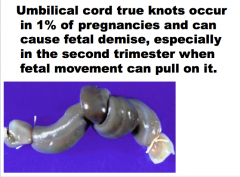
|
|
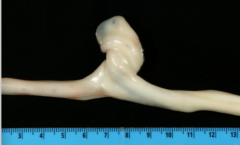
Umbilical cords are normally _____ and _____coiling can create what looks like a ____knot, but is not, a _____ knot.
Are both hyper and hypo coiling of the cord are associated with poor obstetrical outcomes (true or false)? |
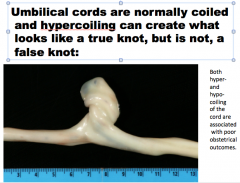
|
|
|
Placental Abruption: bleeding at the ______ interface causing placental ______ before delivery of the fetus.
The detachment can be _____ or total.
It complicates ______ of pregnancies and the incidence is ______. |
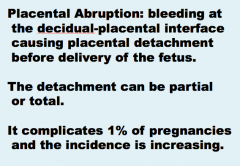
|
|
|
_____ of placental abruptions cause fetal ______ and ______ causes 8% of perinatal mortality.
The immediate cause of abruption is rupture of _______ blood vessels.
This results in a _______ hematoma in 2/3 of cases, but 1/3 of hematomas are without associated _______. |
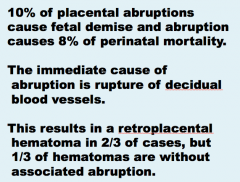
|
|

Complete the chart. |
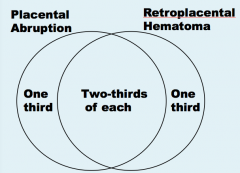
|
|
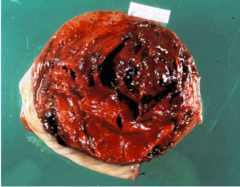
What is this? |
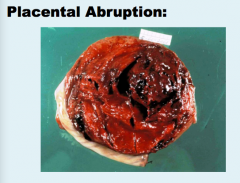
|
|
|
Pulmonary thromboembolism
The risk is _______ up to 50-fold with pregnancy and up to 1 in 500 pregnancies is complicated by pulmonary ________.
|
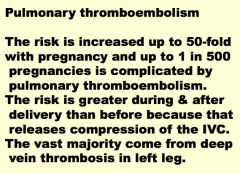
|
|
|
Amniotic fluid embolism
Life-threatening obstetric emergency due to acute ________ failure from pulmonary |
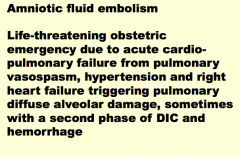
|
|
|
Amniotic fluid embolism
Rare, but true incidence hard to pin down (between 1 in _____ and 1 in ______ deliveries) Thought to be due to ______ and amniotic elements entering maternal veins as _____detaches and embolizing to ______, which react with vasospasm, etc. |
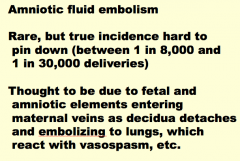
|
|
|
Amniotic fluid embolism
Commonly fatal to the ______, but true fatality rate hard to pin down (between ______ and 80%) Thought to account for _____ of maternal deaths in the US. Less commonly fatal to the ______, but about ______ die after their mothers develop the syndrome. |

|
|
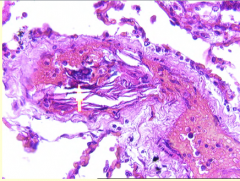
What is this condition? What does the arrow point to? What is under the arrow? There are called what and where do they come from? |

|
|
|
Peripartum Cardiomyopathy
A ________ (possibly _______ mediated) which resolves spontaneously (in 1/3) or leads to _______ cardiomyopathy (in 2/3).
Rare (1:______ to 1:15,000 pregnancies),
Most common in multiparous _________ (race). |

|
|
|
How do you diagnose peripartum cardiomyopathy?
What is the treatment if it fails to resolve spontaneously? |
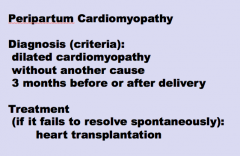
|
|
|
What is the differential for acute onset dyspnea during labor and delivery?
P, P, P, A, A, M |
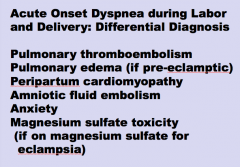
|
|
|
Maternal deaths in the US
The rate of maternal death in the US has been _______ for over 20 years. The mortality rate in postpartum hospitalizations increased _______ between 1999 and 2009. The maternal death rate is 3X higher for ______ women. The five leading causes of maternal death are _______. |
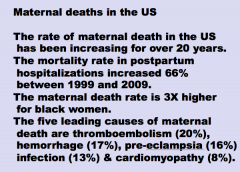
|

